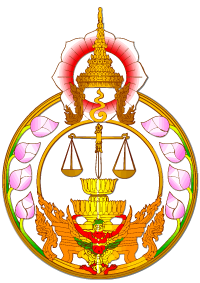
ศาลยุติธรรม
The history of the Thai legal system and the judiciary can be dated back as far as the Sukhothai period (A.D. 1238 - 1350) where the King was the “Fountain of Justice” whohimself adjudicated the disputes between his citizens. During the Ayutthaya period (A.D. 1350 - 1767), the Thai legal system developed and was crystalized in a form which was to last until the close of the nineteenth century. The Dhammasattham derived from the ancient Hindu jurisprudence was established as the law code of the realm and formed part of the Thai national heritage. It was a fundamental law of individual liberty and private rights dealing with both civil and criminal matters. The concept of royal justice administered during the Sukhothai was also carried through the Ayutthaya. The reign of King Taksin the Great between A.D. 1767 - 1782 had little development in the legal field since the country was beset with series of battles. Later at the beginning of the Chakri Dynasty in 1782, the laws derived from the Ayutthaya period were revised and completed in 1805 resulting in the written form of law called “THE LAW OF THREE SEALS.”

It had been the authority of the land until the reign of King Rama V, when a reform of the legal and court system was introduced together with an open door policy of trading with foreign nations.
IN 1882, KING RAMA V FOUNDED THE FIRST BUILDING OF THE COURTS OF JUSTICE.

Later,in 1892, the Ministry of Justice was established and brought about the centralization of all Courts of Justice. Meanwhile,the first law code was promulgated in 1908 on criminal law. The foundering father of modern Thai law was Prince Rabi of Ratchaburi who played a leading role in introducing a modern system of judicial administration. The drafting of the Civil and Commercial Code was started in the reign of King Rama V and was completed during the reign of King Rama VII.


The Revolution of 1932 had an important effect on the Thai legal and judiciary system since it changed the form of government from an absolute monarchy to a constitutional monarchy. The Constitution vested the judiciary power with the Courts. Judges perform their duties in the name of the King and are assured of independence in adjudicating cases according to the law.The Constitution is the supreme law of the land that establishes the powers, functions and duties as well as the structure of the Executive,the Legislative and the Judiciary. The Constitution of the Kingdom of Thailand,B.E. 2540 [1997] has had a substantial impact on the reorganization of the political system as well as the judicial system in Thailand. The types of courts recognized under the 1997 Constitution and also the present 2007 Consititution are the Constitutional Court, the Courts of Justice, the Administrative Courts and the Military Court. The Constitutional Court and the Administrative Court were established as a result of the provisions of such constitution. Although this change decreases the scope of the jurisdiction of the Courts of Justice, most cases fall under the jurisdiction of the Courts of Justice.






